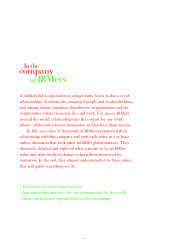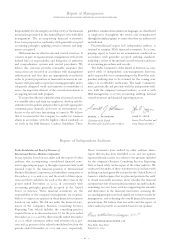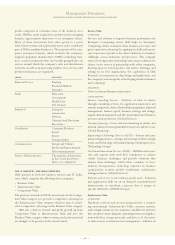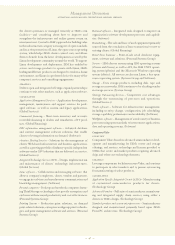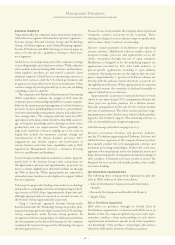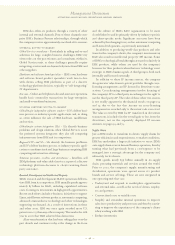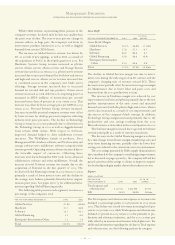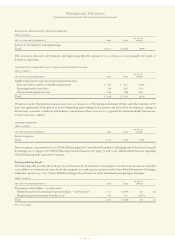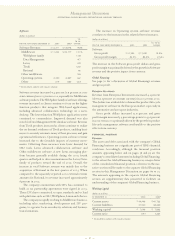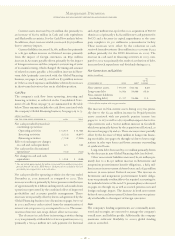IBM 2003 Annual Report Download - page 50
Download and view the complete annual report
Please find page 50 of the 2003 IBM annual report below. You can navigate through the pages in the report by either clicking on the pages listed below, or by using the keyword search tool below to find specific information within the annual report.
BUSINESS SEGMENTS
Organizationally, the company’s major operations comprise a
Global Services segment; three hardware product segments—
Systems Group, Personal Systems Group and Technology
Group; a Software segment; and a Global Financing segment.
See the IT Industry and IBM’s Strategy section on pages 46
and 47 for the specific capabilities relating to these busi-
ness segments.
Global Services is an important part of the company’s strategy
of providing insight and solutions to clients. While solutions
often include industry-leading IBM software and hardware,
other suppliers’ products are also used if a specific client
solution requires it. Global Services outsourcing contracts as
well as BCS contracts with the U. S. federal government and
its agencies are typically seven to ten years in duration. Other
contracts range in periods generally up to one year, including
consulting contracts and ITS.
The company’s new Business Transformation Outsourcing
(BTO) capabilities combine the insight of BCS with the
company’s process outsourcing capabilities to assume responsi-
bility for the operations and management of a client’s business
processes in areas including human resources, procurement,
customer relationship management, finance and administra-
tion, among others. The company will only enter into BTO
agreements with clients when it believes that IBM can lever-
age its business knowledge and technology to drive client
productivity and cost improvements. These generally are
large-scale, multiyear contracts ranging up to ten years in
length that include the operation, strategic change and
transformation of the client’s business processes. BTO
engagements may include support and involvement of
various business units that have capabilities such as BCS,
Application Management Services, e-business Hosting
Services, middleware and hardware.
Systems Group provides business solutions to clients. Approxi-
mately half of the Systems Group’s sales transactions are
through business partners and approximately 46 percent are
direct to clients, slightly more than half of which are through
the Web at ibm.com. While appropriately not reported as
external revenue, hardware is also deployed to support Global
Services solutions.
Technology Group provides leading semiconductor technology
and products, packaging solutions and engineering technol-
ogy services to OEM clients (approximately 78 percent) and,
although appropriately not reported as external revenue, to
the Systems Group (approximately 21 percent).
Using a “one-team” approach, Systems Group works
hand-in-hand with the Technology Group on product plan-
ning and strategy, given the high content level of Technology
Group components inside Systems Group products. In
recognition of the increasing degree of collaboration between
the two segments and as discussed on page 118, the company
combined the Systems Group and the Technology Group in
the first quarter of 2004.
Personal Systems Group includes the company’s lines of personal
computers, printers and point-of-sale terminals. These
offerings are designed to assist clients to improve productivity
and to reduce clients’ total cost of ownership.
Software consists primarily of middleware and operating
systems software. Middleware software enables clients to
integrate systems, processes and applications across the
clients’ enterprises through the use of open standards.
Middleware is designed to be the underlying support for
applications provided by ISVs who build industry- or
process-specific applications according to open industry
standards. Operating systems are the engines that run com-
puters. Approximately 70 percent of Software volumes are
directly with the end-user clients and about 20 percent are
through Business Partners. While appropriately not reported
as external revenue, the remainder is deployed internally to
support Global Services solutions.
Approximately 40 percent of external Software revenue
relates to one-time charge (OTC) arrangements whereby the
client pays one up-front payment for a lifetime license.
Ty pically, arrangements for the sale of OTC software include
one year of maintenance. The client can also purchase ongo-
ing maintenance after the first year, which includes product
upgrades and technical support. The remaining software is
sold on a monthly license charge arrangement.
Global Financing is described on pages 69 to 73.
Enterprise Investments develops and provides industry-
specific IT solutions supporting the Hardware, Software and
Global Services segments of the company. Primary product
lines include product life cycle management software and
document processing technologies. Product life cycle man-
agement software primarily serves the Industrial sector and
helps clients manage the development and manufacturing of
their products. Document processor products service the
Financial Services sector and include products that enable
electronic banking.
IBM WORLDWIDE ORGANIZATIONS
The following three company-wide organizations play key
roles in IBM’s delivery of value to its clients:
•Sales & Distribution Organization and related sales
channels
•Research, Development and Intellectual Property
•Supply Chain
Sales & Distribution Organization
IBM offers its products through its Global Sales &
Distribution organizations. Consistent with IBM’s focus on
Business Value, the company’s global corps of account repre-
sentatives combine a deep understanding of each client’s
organizational and industry-specific needs with comprehen-
sive knowledge of the products, technologies and services
offered by IBM and its network of business partners.
Management Discussion
INTERNATIONAL BUSINESS MACHINES CORPORATION AND SUBSIDIARY COMPANIES
48




